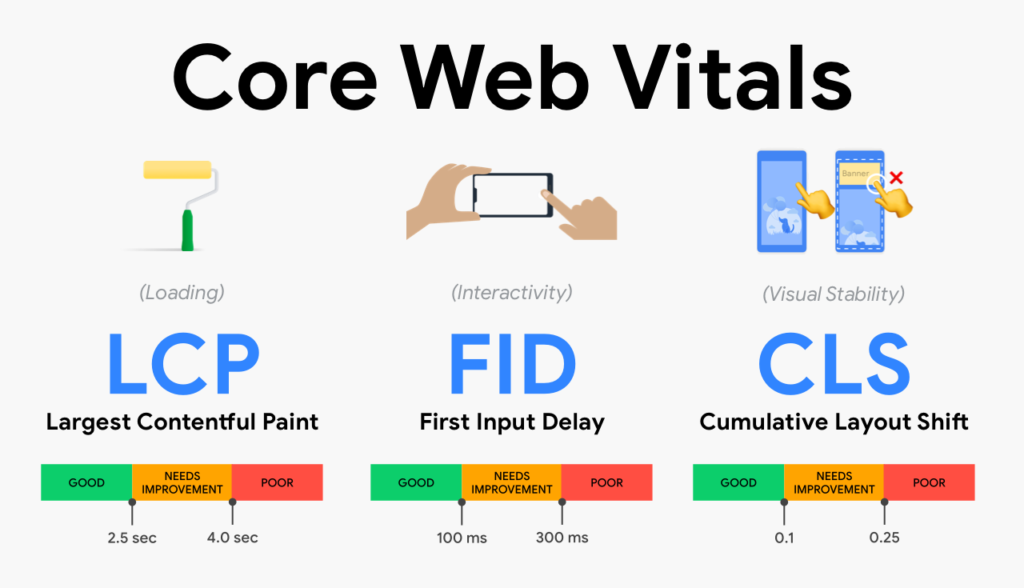
What Is Core Web Vitals
Core Web Vitals are a subset of factors that Google considers critical for SEO & overall user experience. These metrics focus on three key aspects of a webpage:
Loading Performance: Largest Contentful Paint (LCP)
Definition: LCP measures the time it takes for the largest visible content (e.g., an image or text block) on a webpage to load.
Ideal Threshold: Less than 2.5 seconds.
Interactivity: First Input Delay (FID)
Definition: FID gauges the time it takes for a webpage to respond to a user’s first interaction, such as clicking a button or link.
Ideal Threshold: Less than 100 milliseconds.
Visual Stability: Cumulative Layout Shift (CLS)
Definition: CLS measures the sum of unexpected layout shifts that occur during the lifespan of a page.
Ideal Threshold: Less than 0.1.
Why Do Core Web Vitals Matter?
Google uses Core Web Vitals as a ranking factor in its search algorithm, underscoring the importance of user experience in determining a website’s search visibility. Here are a few reasons why Core Web Vitals are vital:
Improved User Experience:
Faster loading times, responsive interactions, and stable layouts ensure that users stay engaged and satisfied.
Higher Search Rankings:
Websites meeting Core Web Vitals thresholds are more likely to rank higher on Google Search.
Increased Conversion Rates:
A seamless user experience can significantly improve conversion rates, reducing bounce rates and cart abandonment.
Mobile-First Indexing:
Core Web Vitals align with Google’s focus on mobile-first indexing, ensuring an optimal experience for mobile users.
How to Measure Core Web Vitals
To optimize your Core Web Vitals, you first need to measure them accurately. Several tools can help:
Google PageSpeed Insights: Provides detailed metrics and suggestions for improvement.
Lighthouse: An open-source tool integrated into Chrome DevTools.
Google Search Console: Offers a dedicated Core Web Vitals report for your website.
WebPageTest: Provides in-depth insights into page performance.
Chrome User Experience Report (CrUX): Real-world user data to assess performance.
Strategies to Optimize Core Web Vitals
Here’s a breakdown of actionable steps to improve each metric:
1. Optimizing Largest Contentful Paint (LCP)
Use fast and reliable hosting.
Optimize and compress images.
Minimize render-blocking resources (e.g., JavaScript and CSS).
Enable browser caching.
Implement lazy loading for images.
2. Reducing First Input Delay (FID)
Minimize JavaScript execution.
Use web workers to run heavy tasks in the background.
Reduce the impact of third-party scripts.
Optimize the main thread by breaking down large tasks.
3. Improving Cumulative Layout Shift (CLS)
Use size attributes for images and videos to reserve space.
Avoid inserting content above existing content unless it is user-initiated.
Ensure web fonts load properly to prevent layout shifts.
Use CSS animations instead of animations that affect layout.
Common Challenges and How to Overcome Them
While optimizing Core Web Vitals, you may encounter several challenges:
Third-Party Scripts: These can slow down loading times. Use asynchronous loading and limit unnecessary scripts.
Large Media Files: Compress and resize media files to improve LCP.
Complex Web Pages: Simplify your website’s design and structure to reduce layout shifts and improve interactivity.
Mobile Responsiveness: Ensure your website is mobile-friendly and performs well on smaller screens.
